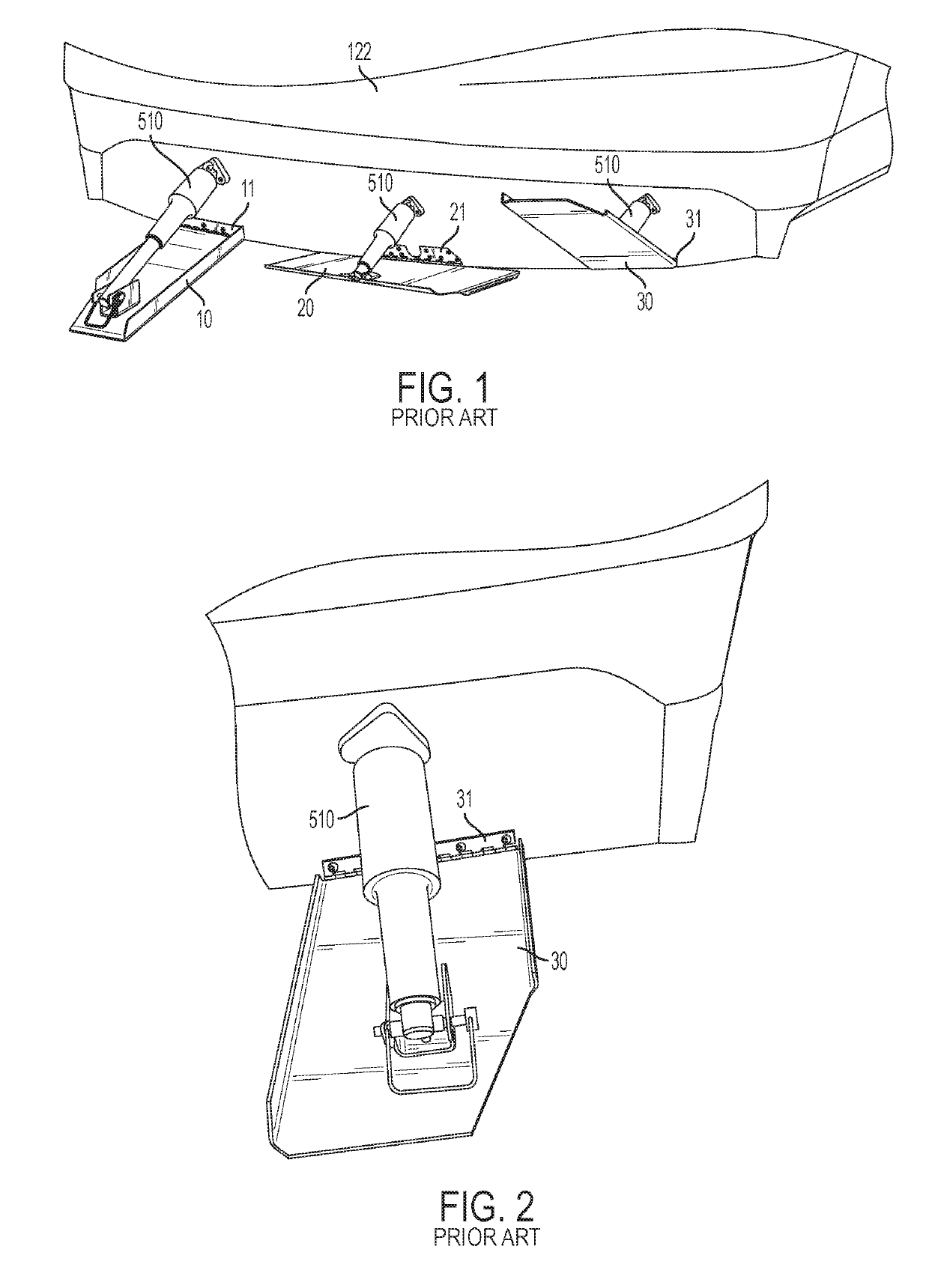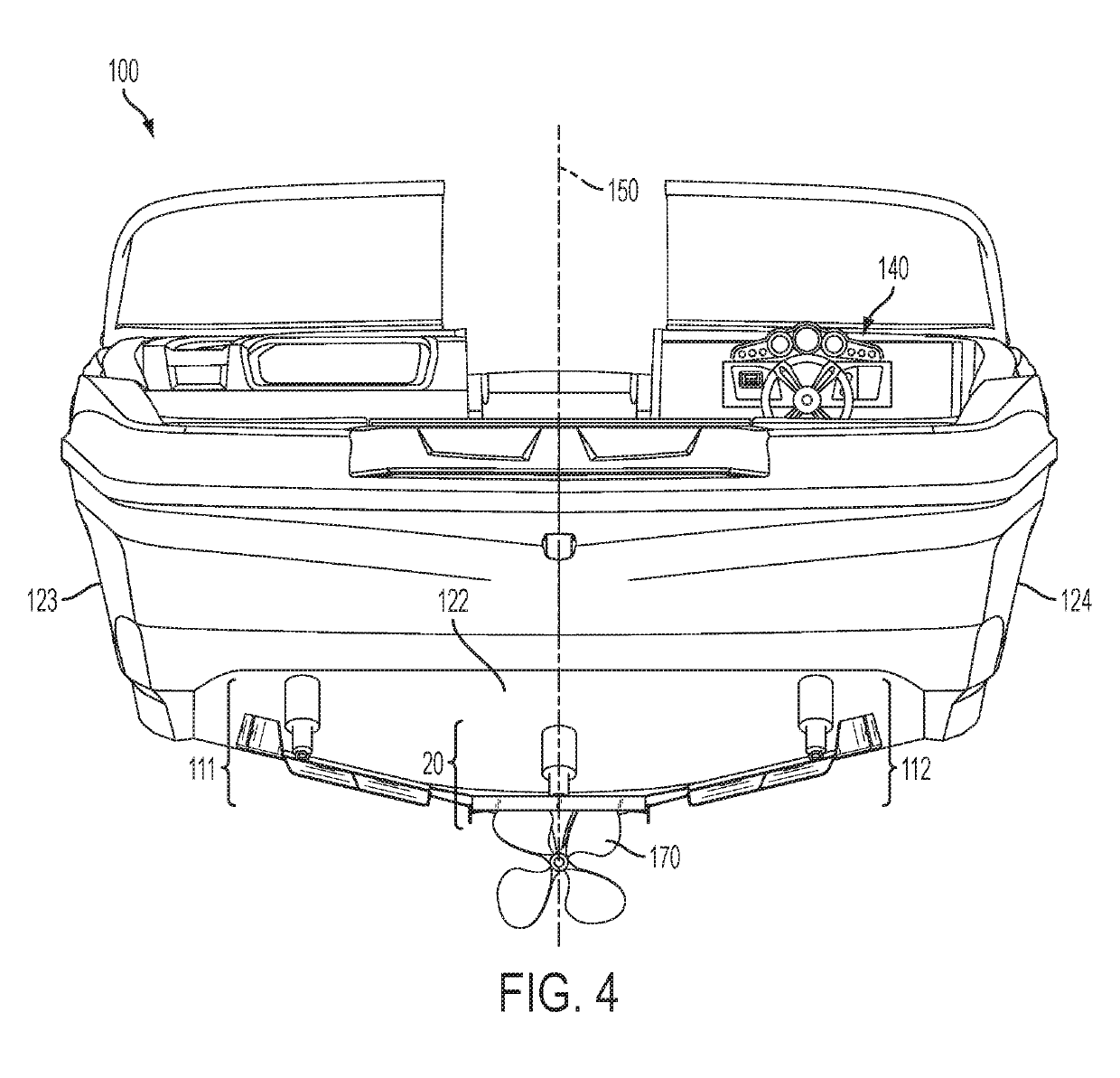Wake-modifying device for a boat
a wake-modifying device and boat technology, applied in special-purpose vessels, vessel construction, vessel movement reduction by foils, etc., can solve the problems of increasing the displacement on the starboard side of the boat, and increasing the size of the starboard wak
- Summary
- Abstract
- Description
- Claims
- Application Information
AI Technical Summary
Benefits of technology
Problems solved by technology
Method used
Image
Examples
first embodiment
[0179]FIGS. 3 and 4 show a boat 100 equipped with a pair of wake-modifying devices 111, 112 in accordance with a first preferred embodiment of the invention. The boat hull 120 includes a bow 121, a transom 122, and port and starboard sides 123, 124. Within the boat's interior is a control console 140 for operating the boat 100. The boat 100 is driven by a single inboard motor (not shown) connected to a left-handed propeller 170. However, the wake-modifying devices 111, 112 can be utilized with other types of boats and propulsion systems, including but not limited to right-handed propellers, outboard motors, sterndrives, and the like.
[0180]The boat 100 has a centerline 150 running down the center of the boat, halfway between the port and starboard sides 123, 124. A conventional trim tab 20 is pivotably attached to the transom 122 along the centerline 150. The wake-modifying devices 111, 112 are pivotably attached to the transom 122 on port and starboard sides of the centerline 150, r...
second embodiment
[0198]Boat design plays an important role in establishing the wake shape. Design factors include, for example, the hull design and the weight of the boat. The wake-modifying device 111, 112 preferably is customized based on the boat design in order to produce the desired wake.
[0199]As an example of how hull design affects the boat's wake, a first boat having a steeper deadrise than a second boat will typically allow the water to recover closer to the transom of the boat. The shape of the corners between the sides of the hull and the transom also impact the recovery of the water. A boat with smooth corners (e.g., having a radius) will allow the water to recover faster than will a boat with square corners. The wake-modifying devices 111, 112 of the second embodiment are designed to provide greater lift to the boat on the non-surf side and further delay and direct the water on the non-surf side.
[0200]FIG. 31 shows a stern view of a boat 100 equipped with wake-modifying devices 111, 112...
third embodiment
[0203]The port and starboard wake-modifying devices 111, 112 in the previous two embodiments are asymmetrical with each other, but the wake-modifying devices 111, 112 can be symmetrical. Symmetrical wake-modifying devices 111, 112 may be used, for example, with heavy boats where the propeller 170 has less of an impact on the boat's wake. The third preferred embodiment shown in FIGS. 58-84 is an example of a symmetrical pair of wake-modifying devices 111, 112. FIG. 58 shows a stern view of a boat 100 equipped with wake-modifying devices 111, 112 according to a third embodiment of the invention. The port wake-modifying device 111 of the third embodiment is shown in FIGS. 59-72. The starboard wake-modifying device 112 of the third embodiment is shown in FIGS. 73-84. In this embodiment, both the port and starboard wake-modifying devices 111, 112 have two fins 340, 350. In the embodiment shown, the fins 340, 350 are parallel to each other and oriented at an angle θ of 45° relative to the...
PUM
 Login to View More
Login to View More Abstract
Description
Claims
Application Information
 Login to View More
Login to View More - R&D
- Intellectual Property
- Life Sciences
- Materials
- Tech Scout
- Unparalleled Data Quality
- Higher Quality Content
- 60% Fewer Hallucinations
Browse by: Latest US Patents, China's latest patents, Technical Efficacy Thesaurus, Application Domain, Technology Topic, Popular Technical Reports.
© 2025 PatSnap. All rights reserved.Legal|Privacy policy|Modern Slavery Act Transparency Statement|Sitemap|About US| Contact US: help@patsnap.com



